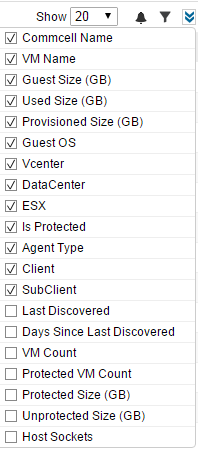You can get virtual machine information for one or more CommCell environments by connecting to each vCenter and getting information for protected and unprotected virtual machines That information is used to generate a Virtual Machine Infrastructure Report that can be used to summarize the coverage needed for your current VMware environment. You can also use the report as a basis for requesting capacity licenses or socket licenses for VM protection.
Note
-
To get a separate listing of unprotected virtual machines, see Creating an Alert for Unprotected VMs.
-
This report is specific to VMware. For other hypervisors, see System Discovery Tool for Virtual Machines.
Process for Generating the Report
The basic process to create the Virtual Machine Infrastructure Report is as follows:
-
Create required additional settings.
-
Request a Refresh Datacenters operation on the VMware instance for each VMware virtualization client.
-
View the report through Cloud Services on your Metrics Server.
Before You Begin
-
To ensure that the current virtual machine guest sizes are collected, ensure that VM Tools are installed and running on each guest VM.
-
If VM Tools are not running on a guest VM or if the VM is powered off, the Used Space for the VM is used to calculate the guest size for the VM.
-
The report includes information for template VMs. Guest sizes for template VMs will be calculated based on the Used Size for the template VMs.
Creating Additional Settings
Create the following additional settings:
-
To enable the collection of VM data, create the nGetVMInfoForCustomReport additional setting for the VSA proxy with a value of 1.
-
To limit the time required to discover virtual machine data, create the VS Client discovery timeout additional setting for the CommServeDB.gxglobalparam with a value of 120 (minutes).
Refresh Datacenters to Discover Virtual Machines
To discover virtual machine data, perform the following steps on the virtualization client for each VMware vCenter:
-
From the CommCell Console, expand the Client Computers node to display clients.
-
Under the virtualization client, right-click the VMware instance and select Refresh Datacenters.
-
In the Refresh Datacenters dialog box, select both available options: Refresh VM status and Discover VMs.
-
Click OK.
-
Repeat for all other virtualization clients to be included in the report. If multiple CommCell systems are to be included, repeat the operation for those CommCell systems.
Depending on the number of virtual machines, the Refresh Datacenters operation can take some time. The maximum time for the operation can be set using the VS Client discovery timeout additional setting. Collecting information about ESXi hosts and VMs does not have a significant impact on vCenter operations.
Note
-
To refresh datacenter information automatically, download and deploy the Refresh Datacenters workflow from the Commvault Store. You can use that workflow to schedule automatic refreshes for configured vCenters.
-
Discovered VMs appear in the Client Computers list in the CommCell Browser when you display VM clients
-
Unprotected VMs do not count in Missed SLA calculations.
Viewing the Report
The report is generated automatically after virtual machine data has been discovered. To view the report, perform the following steps:
-
After the Refresh Datacenters operation has completed, log in to Cloud Services on your Metrics Server.
-
Click Reports.
-
Click the blue down arrow icon at the top right (Download from Store).
-
Enter your user name and password for the Cloud Services site, and then click Login.
-
On the Commvault Store page, search for Virtual Machine Infrastructure Report.
-
Next to Virtual Machine Infrastructure Report, click Install.
-
After the install operation completes, click Open to display the report.
After opening the report, the report is available on the main Reports page under the Untagged listing.
Information in the Report
The Summary section of the report provides information that you can use to estimate the required storage capacity for backup data. The Protected Size and Unprotected Size values display the sum of guest sizes for virtual machines in each of those categories. If the report is configured to include multiple CommCell systems, each row of the summary provides statistics for the CommCell.
You can also use the Summary information to provide information required for licensing:
-
For capacity licenses, use the value in the Unprotected Size column to increase the licensed capacity.
-
For socket licenses, use the value in the Host Sockets column to identify the number of required socket licenses.
Important
In estimating storage and licensing requirements, ensure that planned growth in your environment is included.
The Details section of the report provides additional information about each virtual machine. If an agent is installed on a virtual machine the IsAgentExists column has Yes as the value and the Agents column shows the type of agent.
You can use the controls at the right side of the Details section to configure alerts, apply filters, or add columns to be displayed in the report. The following graphic shows the control for adding columns.

Sample Report
